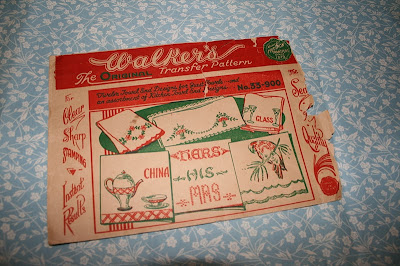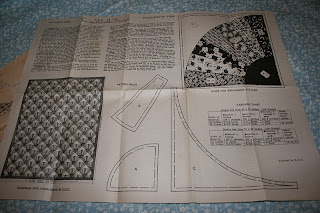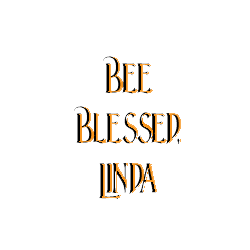 Quilters and Embroiderers have used patterns for a very long time. This is the way they shared designs and passed them on. In 1974, my husband and I visited his Aunt Rubye. She was a remarkable "needleworker" who made a living at one time by embroidering monograms on shirts for Neiman-Marcus! (There were enough oil millionaires back then for her to do that!) She was also an accomplished quilter and seamstress. She was born before the turn of the century and learned as a young girl how to sew and embroider. On this visit, Aunt Rubye showed me her "workshop" - a creative jumble of project areas for crafting, sewing, and quilting. She pulled out her embroidery patterns and when she saw my jaw drop over the old patterns, she gave me a few. (I was only 24 at the time and these treasures seemed ancient to me!) I have treasured them over the years. They are extremely special to me, not only because they are old, but because they were hers.
Quilters and Embroiderers have used patterns for a very long time. This is the way they shared designs and passed them on. In 1974, my husband and I visited his Aunt Rubye. She was a remarkable "needleworker" who made a living at one time by embroidering monograms on shirts for Neiman-Marcus! (There were enough oil millionaires back then for her to do that!) She was also an accomplished quilter and seamstress. She was born before the turn of the century and learned as a young girl how to sew and embroider. On this visit, Aunt Rubye showed me her "workshop" - a creative jumble of project areas for crafting, sewing, and quilting. She pulled out her embroidery patterns and when she saw my jaw drop over the old patterns, she gave me a few. (I was only 24 at the time and these treasures seemed ancient to me!) I have treasured them over the years. They are extremely special to me, not only because they are old, but because they were hers. These embroidery patterns have been transferred to old brown paper grocery bags. They have designs that appear to have been from around the turn of the century. The paper appears to be waxed or oiled, which I'm sure has kept it from falling apart.
I have no idea when these patterns were produced, but they are Butterick Transfer Patterns and I do know that Butterick made transfer patterns between 1863 and the early to mid 1930's..They are pattern #10436. I was unable to find out anything more than that.
The patterns below early examples from the Joseph Walker Co. These patterns are from the late 1930's. The first was designed to iron onto children's clothing, crib covers, pillows, aprons, etc. to "give an embroidered effect". The second was an iron on transfer meant to be embroidered.
The Vogart pattern below was from after 1959, since it included Hawaii and Alaska as states.
Below are some Laura Wheeler Designs. These were sold through newspapers. The first one below is from 1946. The second one (with the baby design) is from 1960.

The last one I will show is also a pattern ordered from the newspaper. The address label on the envelope has been cut from the newspaper and filled out by the person who ordered it. This is from 1976. That was the year when quilting here in the United States had a resurgence. This was the Bi-Centennial year for this country and many "old" crafts were being revisited for fairs, school projects, demonstrations, etc. This soon carried over into home decor. I remember a popular wallpaper I wanted that had reproductions of old Sears & Roebuck catalog pages from the 1800's. Quilt patterns came out in magazines and many women started quilting again because there was a new appreciation for old crafts. The pattern here is one for a State Bird quilt.
I really love OLD things like this! I don't know if it's the history behind them that intrigues me, or the "romantic" ideas I form in my imagination about the people using them and the times they lived in. Some day maybe I'll make a quilt with some of these embroidery patterns worked up in the centers of blocks. If nothing else, I feel inspired when I look through them and that's worth a lot to me.




















































